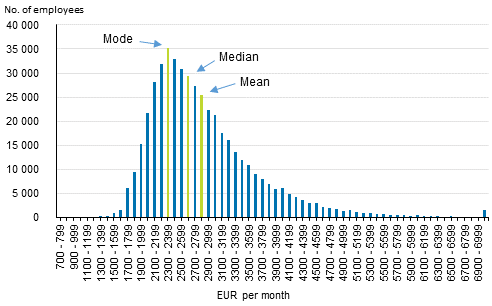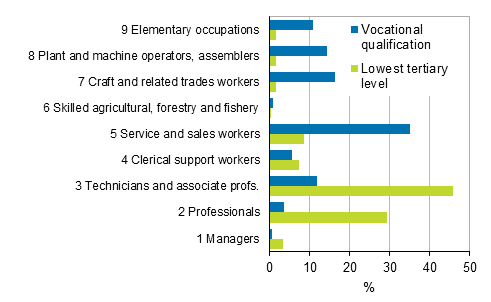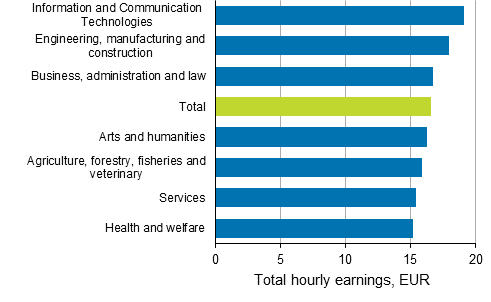Published: 6 September 2019
Most common monthly earnings of full-time wage and salary earners with vocational qualifications was EUR 2,300 in 2018
According to Statistics Finland’s Structure of Earnings statistics, the most common monthly earnings of full-time wage and salary earners with vocational qualifications was EUR 2,300 per month in 2018. Besides basic pay, total earnings include all bonuses, overtime pay and benefits in kind, but not performance-based bonuses or holiday bonuses. Total earnings are in gross, so taxes or other payments have not been subtracted from them.
Distribution of total monthly earnings of full-time wage and salary earners with vocational qualifications in 2018

The Structure of Earnings statistics describe wage and salary earners working in enterprises with more than five employees in the public and private sectors. The figure above shows the number of full-time wage and salary earners with vocational qualifications by total earnings.
In the figure, total earnings have been divided into categories of EUR one hundred. There were most wage and salary earners with vocational qualifications in the category EUR 2,300 to 2,399, around 35,000 persons. This is the most common (mode) earnings category. The most typical occupational groups in this group were, e.g. childminders in kindergartens, social work assistants and building caretakers.
The median of total earnings of full-time wage and salary earners with vocational qualifications was EUR 2,694 per month and the average was EUR 2,881. Half earned less than the median, half more. By contrast, 60 per cent of full-time wage and salary earners with vocational qualifications earned less than the average. This is explained by the fact that the biggest total earnings raise the average.
The most common monthly earnings of all full-time wage and salary earners, not just those with vocational qualifications, was EUR 2,600 per month in 2018. Correspondingly, the median was EUR 3,079 and the average EUR 3,465 per month.
From vocational school to service, construction and manufacturing industry professions
Of all wage and salary earners included in the Structure of Earnings statistics, 36 per cent have completed vocational qualifications.
According to the National Classification of Education 2016, wage and salary earners who have complete basic vocational education or vocational qualification are considered wage and salary earners with vocational qualifications. Those wage and salary earners, who, after vocational school, have completed lowest tertiary level or tertiary level education are not included in the groups of persons with vocational qualifications.
Share of part-time and full-time wage and salary earners by education and occupational group in 2018

A majority of those with vocational qualifications, 35 per cent, worked as service and sales workers in 2018. The most common occupational groups in this group are various care workers, such as social work assistants, childminders in kindergartens, health care assistants and home help workers. The number of those working as a salesperson was also considerable.
Among other main groups of the classification of occupations, the most common occupational categories were trades workers in different industries, construction and transport workers, workers in the paper and metal industries, cleaning workers and freight handlers.
In total, 0.4 per cent, or four persons of one thousand, of those with vocational qualifications worked as managers.
The figure above shows, for reference, the main groups of the classification of occupations of wage and salary earners with lowest tertiary level degrees, i.e. degree from a university of applied sciences or a bachelor's degree. In 2018 they mainly worked in expert occupations.
Most common occupation of those with vocational qualifications is salesperson
The most common occupation of part and full-time wage and salary earners with vocational qualifications is salesperson according to the Classification of Occupations 2010. This extensive occupational group includes, among others, cashiers, salespersons in retail shops and salespersons in car showrooms.
The median of part and full-time salespersons’ total hourly earnings was EUR 14.5 in 2018. One-half of salespersons, or around 19,000 wage and salary earners earned less than EUR 14.5 per hour and one-half more.
Besides basic pay and scheduled pay, total hourly earnings, include all bonuses, overtime pay and benefits in kind, and taxes or other payments have not been subtracted from them.
Total hourly earnings are defined by dividing wage and salary earners’ total monthly earnings by regular weekly working hours and hours of extra and overtime work. Regular weekly working hours are not based on hours worked, but on hours for which pay has been paid. Therefore, short sickness absences or grey overtime work have no effect on regular working hours.
Days off granted to shorten working time (so-called pekkaset) have since the statistical reference year 2018 been included in working hours, see changes in these statistics (only in Finnish and Swedish).
Numbers and earnings in the most common occupational groups of wage and salary earners with vocational qualifications in 2018
| Occupation | Number | Total hourly earnings, median |
| 5223 Shop sales assistants | 38 008 | 14.5 |
| 53213 Social work assistants | 30 069 | 15.9 |
| 53111 Childminders in kindergartens | 21 364 | 13.6 |
| 91121 Office cleaners, etc. | 18 158 | 11.7 |
| 8332 Heavy truck and lorry drivers | 15 527 | 16.2 |
| 9333 Freight handlers | 14 623 | 14.7 |
| 53219 Other practical nurses | 13 341 | 16.2 |
| 5153 Building caretakers | 12 735 | 14.0 |
| 53221 Household service workers | 11 823 | 15.4 |
| 34121 Social instructors | 11 204 | 15.7 |
Earnings of persons with vocational qualifications vary by field of study
The field of study of vocational education was linked with the level of hourly earnings in 2018. The median hourly earnings of those with a qualification in the field of information and communication technology was EUR 3.9 higher than for wage and salary earners with a qualification in health and welfare. Thus, the difference in hourly earnings was more than 20 per cent to the favour of ICT.
In addition to information and communication technology, the highest median earnings were found among graduates from technology (EUR 17.9) and trade (EUR 16.7).
Typical qualifications in these fields of education were diploma in information and communication technology, diploma in machinery, the metal industry, construction, electrics and the automobile sector, diploma in house building, and diploma in business and administration.
Over one-half of wage and salary earners with vocational qualifications in the field of health and welfare had completed vocational qualifications of a practical nurse in 2018. The share of those with vocational qualifications of practical nurse among all wage and salary earners with vocational qualifications was 13 per cent.
Median of total hourly earnings of wage and salary earners with vocational qualifications by field of education in 2018

Higher earnings for those with vocational qualifications in male dominated fields
The higher the share of men among those who had completed vocational qualifications in a particular field, the higher the income level among wage and salary earners with a qualification in 2018.
This can be seen in the figure below. It depicts every vocational education qualification with over 250 wage and salary earners in 2018 as a separate dot. A median of total hourly earnings has been calculated for each qualification, as well as the share of men among wage and salary earners with each qualification.
The second major finding in the figure is the gender distribution between qualifications. Several qualifications were clearly female or male-dominated in 2018. Qualifications where the share of men was between 60 and 80 per cent were rarest.
Median of total earnings of vocational qualifications and share of men among all qualification completers in 2018

Examples of female-dominated qualifications were beauty care qualifications, practical dental nurse qualifications and practical nurse qualifications. Male-dominated qualifications included, e.g. pipefitter, construction worker and aircraft maintenance technician qualifications.
Source: Structure of Earnings 2018, Statistics Finland
Inquiries: Sampo Pehkonen 029 551 3452, Jukka Pitkäjärvi 029 551 3356, palkkarakenne@stat.fi
Director in charge: Mari Ylä-Jarkko
Publication in pdf-format (242.4 kB)
- Tables
-
Tables in databases
Pick the data you need into tables, view the data as graphs, or download the data for your use.
Appendix tables
Updated 6.9.2019
Official Statistics of Finland (OSF):
Structure of Earnings [e-publication].
ISSN=1799-0092. 2018. Helsinki: Statistics Finland [referred: 6.12.2025].
Access method: http://stat.fi/til/pra/2018/pra_2018_2019-09-06_tie_001_en.html

